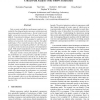Free Online Productivity Tools
i2Speak
i2Symbol
i2OCR
iTex2Img
iWeb2Print
iWeb2Shot
i2Type
iPdf2Split
iPdf2Merge
i2Bopomofo
i2Arabic
i2Style
i2Image
i2PDF
iLatex2Rtf
Sci2ools
ISPASS
2006
IEEE
2006
IEEE
Critical path analysis of the TRIPS architecture
Fast, accurate, and effective performance analysis is essential for the design of modern processor architectures and improving application performance. Recent trends toward highly concurrent processors make this goal increasingly difficult. Conventional techniques, based on simulators and performance monitors, are ill-equipped to analyze how a plethora of concurrent events interact and how they affect performance. Prior research has shown the utility of critical path analysis in solving this problem [5, 18]. This analtracts the execution of a program with a dependence graph. With simple manipulations on the graph, designers can gain insights into the bottlenecks of a design. This paper extends critical path analysis to understand the performance of a next-generation, high-ILP architecture. The TRIPS architecture introduces new features not present in conventional superscalar architectures. We show how dependence constraints introduced by these features, specifically the execution mo...
| Added | 12 Jun 2010 |
| Updated | 12 Jun 2010 |
| Type | Conference |
| Year | 2006 |
| Where | ISPASS |
| Authors | Ramadass Nagarajan, Xia Chen, Robert G. McDonald, Doug Burger, Stephen W. Keckler |
Comments (0)

